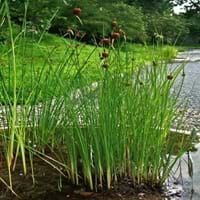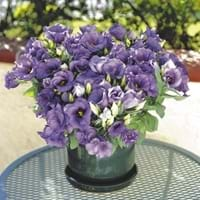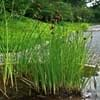Life Span
Perennial
Biennial
Type
Aquatics
Flowering Plants, Grass, Herbs
Origin
Eastern Europe, Western Asia
Southwestern United States, Mexico
Types
Common Cattail, Southern Cattail, Dwarf Bulrush
'Balboa White' lisianthus, 'Forever Blue' lisianthus, 'Forever White' lisianthus, 'Lisa Pink' lisianthus
Number of Varieties
Not Available
Habitat
Lake margins, Ponds, Swamps
Grassland, Warmer regions
USDA Hardiness Zone
3-11
8-11
Sunset Zone
21,22
1a, 1b, 2a, 2b, 3a, 3b, 4, 5, 6, 7, 8, 9, 10, 11, 12, 13, 14, 15, 16, 17, 18, 19, 20, 21, 22, 23, 24
Habit
Upright/Erect
Upright/Erect
Minimum Height
Not Available
Minimum Width
Not Available
Flower Color
Yellow, Green, Brown, Chocolate
White, Blue, Pink, Lavender, Blue Violet
Flower Color Modifier
Not Available
Bicolor
Fruit Color
Light brown, Light Red
Not Available
Leaf Color in Spring
Green, Dark Green
Gray Green
Leaf Color in Summer
Green, Dark Green
Gray Green
Leaf Color in Fall
Green, Dark Green
Gray Green
Leaf Color in Winter
Brown
Gray Green
Leaf Shape
Long linear and narrow
Succulent
Plant Season
Summer, Fall, Winter
Spring, Summer
Sunlight
Full Sun, Partial Sun
Full Sun, Partial Sun
Type of Soil
Clay, Loam, Sand
Clay, Loam, Sand
The pH of Soil
Acidic, Neutral
Neutral, Alkaline
Soil Drainage
Poorly Drained
Well drained
Bloom Time
Summer, Late Summer, Early Fall
Spring, Late Spring, Early Summer, Summer, Late Summer
Tolerances
Wet Site
Not Available
Where to Plant?
Container, In Water
Container, Ground, Pot
How to Plant?
Runners
Seedlings, Stem Planting
Plant Maintenance
Low
Medium
Watering Requirements
Plant grows in water
Form a Soil ring to water efficiently, It cannot sustain wet-feet, Keep the ground moist but not water-logged, Use Mulches to help prevent water loss during hot and windy weather, Water twice a day in the initial period
In Summer
Aquatic Plant
Lots of watering
In Spring
Aquatic Plant
Moderate
In Winter
Aquatic Plant
Average Water
Soil pH
Acidic, Neutral
Neutral, Alkaline
Soil Type
Clay, Loam, Sand
Clay, Loam, Sand
Soil Drainage Capacity
Poorly Drained
Well drained
Sun Exposure
Full Sun, Partial Sun
Full Sun, Partial Sun
Pruning
Prune in early spring, Remove damaged leaves, Remove dead branches, Remove dead leaves
Cut or pinch the stems, Prune ocassionally, Remove dead or diseased plant parts, Remove deadheads
Fertilizers
Nitrogen, Phosphate
All-Purpose Liquid Fertilizer
Pests and Diseases
Red blotch
Botrytis Blight, Cercospora leaf spot, Cucumber mosaic, Curvularia blotch, Downy mildew, Fusarium stem rot, Fusarium wilt, Impatiens necrotic spot, Lisianthus necrosis, Phyllosticta leaf spot, Pythium root rot, Rhizoctonia stem rot, Sclerophoma stem blight, Tobacco mosaic
Plant Tolerance
Drought
Drought
Flower Petal Number
Single
Single, Double, Semi-Double
Foliage Texture
Medium
Medium
Foliage Sheen
Matte
Matte
Attracts
Birds, Flying insects
Bees, Butterflies
Allergy
no allergic reactions
Chest tightness, Diarrhea, Dizziness, Nausea, Vomiting
Aesthetic Uses
Beautification, Showy Purposes, Water gardening
Beautification, Bouquets, Showy Purposes, Used for decorating walls, fences, gates, hedges, etc.
Beauty Benefits
Not Available
Not Available
Environmental Uses
Food for animals, Food for birds, Food for insects, Nesting sites for birds
Air purification
Medicinal Uses
Nutrients
Not Available
Part of Plant Used
Leaves
Flowers
Other Uses
Decoration Purposes, Showy Purposes, Used as Ornamental plant
Showy Purposes, Used for fragrance
Used As Indoor Plant
Yes
Yes
Used As Outdoor Plant
Yes
Yes
Garden Design
Bog Garden, Container, Water Gardens
Bedding Plant, Container, Cutflower, Mixed Border, Wildflower
Botanical Name
TYPHA minima
EUSTOMA grandiflorum
Common Name
Dwarf Cattail
Lisianthus, Florida blue,bBuebell
In Hindi
बौना कैटेल
Lisianthus
In German
Dwarf Rohrkolben
Lisianthus
In French
Cattail nain
Lisianthus
In Spanish
Espadaña enano
Lisianthus
In Greek
Νάνος Cattail
Lisianthus
In Portuguese
Tifa Dwarf
Lisianthus
In Polish
Dwarf Ożypałka
Eustoma
In Latin
Pumilio Cattail
Lisianthus
Phylum
Tracheophyta
Magnoliophyta
Class
Liliopsida
Magnoliopsida
Family
Typhaceae
Gentianaceae
Clade
Angiosperms, Commelinids, Monocots
Angiosperms, Asterids, Eudicots
Tribe
Not Available
Chironieae
Subfamily
Not Available
Not Available
Number of Species
Not Available
Season and Care of Dwarf Cattail and Florida Blue
Season and care of Dwarf Cattail and Florida Blue is important to know. While considering everything about Dwarf Cattail and Florida Blue Care, growing season is an essential factor. Dwarf Cattail season is Summer, Fall and Winter and Florida Blue season is Summer, Fall and Winter. The type of soil for Dwarf Cattail is Clay, Loam, Sand and for Florida Blue is Clay, Loam, Sand while the PH of soil for Dwarf Cattail is Acidic, Neutral and for Florida Blue is Neutral, Alkaline.
Dwarf Cattail and Florida Blue Physical Information
Dwarf Cattail and Florida Blue physical information is very important for comparison. Dwarf Cattail height is 30.50 cm and width 45.70 cm whereas Florida Blue height is Not Available and width Not Available. The color specification of Dwarf Cattail and Florida Blue are as follows:
Dwarf Cattail flower color: Yellow, Green, Brown and Chocolate
Dwarf Cattail leaf color: Green and Dark Green
Florida Blue flower color: White, Blue, Pink, Lavender and Blue Violet
- Florida Blue leaf color: Gray Green
Care of Dwarf Cattail and Florida Blue
Care of Dwarf Cattail and Florida Blue include pruning, fertilizers, watering etc. Dwarf Cattail pruning is done Prune in early spring, Remove damaged leaves, Remove dead branches and Remove dead leaves and Florida Blue pruning is done Cut or pinch the stems, Prune ocassionally, Remove dead or diseased plant parts and Remove deadheads. In summer Dwarf Cattail needs Aquatic Plant and in winter, it needs Aquatic Plant. Whereas, in summer Florida Blue needs Lots of watering and in winter, it needs Average Water.





